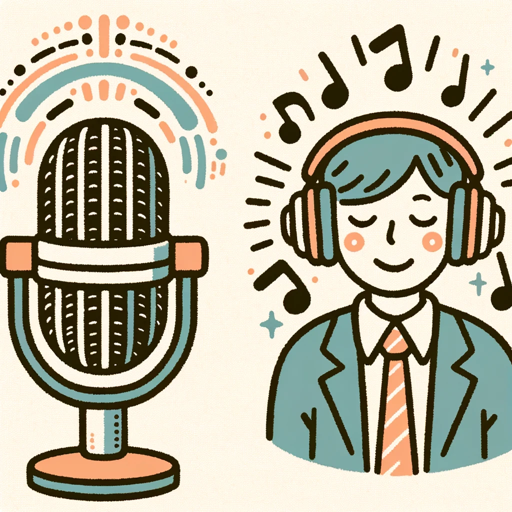Voice Decoder-accurate speech-to-text tool
AI-Powered Speech Recognition
How do I improve speech recognition accuracy?
What are the latest trends in speech recognition?
How can I handle different accents in my voice app?
Tips for noisy environment speech processing?
Related Tools
Load More
AI Voice Generator
Say things with OpenAI text to speech.

Voice Creator
Transforms text into lifelike spoken audio, offers multiple AI voices, and assists in script generation.

AI Code Detector
The ChatGPT Code Detector is designed to analyze and detect if a given piece of code was generated by ChatGPT or any other AI model. It provides insights based on coding style, structure, and syntax that are indicative of AI-generated code.

Voice Engine Text To Speech
Converts text to speech, max 4096 chars, 6 voices

Your Voice
I transform text into speech, matching voices from audio or video snippets, with a comforting tone.

Voice Changer
Guides on voice changing
20.0 / 5 (200 votes)
Introduction to Voice Decoder
Voice Decoder is a specialized tool designed to accurately convert spoken language into text. It leverages advanced speech recognition algorithms to understand and process a wide range of accents, dialects, and noisy environments. Voice Decoder aims to enhance communication and accessibility by providing reliable and efficient speech-to-text services. For example, in a scenario where a virtual assistant needs to transcribe a meeting with participants from different regions, Voice Decoder ensures that all spoken inputs are accurately captured and transcribed, regardless of the speakers' accents or background noise.

Main Functions of Voice Decoder
Accurate Speech Recognition
Example
Transcribing multi-speaker conversations in a meeting
Scenario
During a corporate meeting with participants from different countries, Voice Decoder accurately transcribes the conversation, capturing each speaker's input regardless of accent or background noise.
Dialect and Accent Handling
Example
Customer service interactions
Scenario
In a customer service call center, Voice Decoder identifies and accurately transcribes calls from customers speaking in various regional dialects and accents, improving the service's efficiency and accuracy.
Noise Reduction
Example
Field reporting
Scenario
A journalist reporting from a noisy event can use Voice Decoder to transcribe interviews and speeches accurately, even with significant background noise, ensuring that important details are not lost.
Ideal Users of Voice Decoder
Corporate Professionals
Professionals in various industries who need accurate transcription services for meetings, interviews, and conferences. They benefit from Voice Decoder's ability to handle diverse accents and noisy environments, ensuring clear and reliable transcriptions.
Customer Service Teams
Customer service representatives who deal with a wide range of customers from different regions. Voice Decoder helps in accurately understanding and transcribing customer interactions, leading to improved service quality and customer satisfaction.

Detailed Guidelines for Using Voice Decoder
Step 1
Visit aichatonline.org for a free trial without login, no need for ChatGPT Plus.
Step 2
Ensure you have a stable internet connection and a microphone-enabled device for optimal performance.
Step 3
Choose the appropriate language and accent settings to match your speaking style for accurate recognition.
Step 4
Speak clearly and at a moderate pace, minimizing background noise to improve transcription accuracy.
Step 5
Review and edit the transcribed text as needed, and utilize export options to save or share your work.
Try other advanced and practical GPTs
SEO Wordsmith Advanced
AI-powered content creation for SEO success

Scrape Master
AI-powered solutions for technical challenges.

Hoops Insight
AI-powered NBA insights for smarter decisions.

PENN-M (Sandbox)
AI-Powered Business Strategy for Innovators
Paw Pal
AI-driven guidance for confident dog ownership

行銷AI助理 Marketing AI Assistant
AI-driven solutions for smarter marketing

Pin Addict
AI-powered Pinterest strategy expert

PIC to GIF
Bring your photos to life with AI

Illustration Transformer
AI-powered enhancement for academic illustrations.

Knowlege Graph Builder
AI-powered tool for building knowledge graphs from text.

Islam GPT
AI-powered Quranic guidance for everyday life.

Code Translator
AI-powered code translation tool

- Academic Writing
- Content Creation
- Customer Service
- Virtual Assistance
- Meeting Transcriptions
Detailed Q&A about Voice Decoder
What are the key features of Voice Decoder?
Voice Decoder offers real-time speech-to-text conversion, supports multiple languages and accents, provides high accuracy in noisy environments, and includes easy text editing and export options.
How does Voice Decoder handle different accents and dialects?
Voice Decoder employs advanced machine learning models that are trained on diverse datasets, enabling it to accurately recognize and transcribe speech from various accents and dialects.
Can Voice Decoder be integrated into other applications?
Yes, Voice Decoder provides APIs that developers can use to integrate its speech recognition capabilities into various applications, such as virtual assistants, transcription services, and customer service bots.
Is Voice Decoder effective in noisy environments?
Voice Decoder uses sophisticated noise-cancellation algorithms to minimize background noise, ensuring high transcription accuracy even in noisy environments.
What are the common use cases for Voice Decoder?
Voice Decoder is commonly used for academic writing, meeting transcriptions, customer service, virtual assistance, and content creation, where accurate speech-to-text conversion is essential.